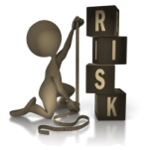
Why risk measurement is important?
- For investors, you need to understand the inherent risk level in order to select the right strategy for achieving the defined objective.
- For advisers, you need to make an unbiased risk assessment of your clients without being influenced by their emotions.
The challenge of measuring investors' risk tolerance for their defined investment objective has been more of an art than a science in the past. A better scientific system to help to measure risk level will greatly benefit investors to stay the course to achieve their goals.
One popular risk assessment question is "What is your goal for this investment?" The designed answers can be from "conservative" to "aggressive". Real life experiences show that investors only care about making money, Investors think conservative when the market is down and want to be more aggressive when the market is up. Advisers often fail to convince clients to stay the course due to the difficulty of managing investors' emotional risks.
We developed TEN behavioral assessment questions by examining FOUR types of investors' personalities to come up with a simple 10-points scoring system. An investment portfolio with its matching risk level can then be designed and measured accordingly.
One popular risk assessment question is "What is your goal for this investment?" The designed answers can be from "conservative" to "aggressive". Real life experiences show that investors only care about making money, Investors think conservative when the market is down and want to be more aggressive when the market is up. Advisers often fail to convince clients to stay the course due to the difficulty of managing investors' emotional risks.
We developed TEN behavioral assessment questions by examining FOUR types of investors' personalities to come up with a simple 10-points scoring system. An investment portfolio with its matching risk level can then be designed and measured accordingly.
The new 4T-10C Risk Measurement System
- Each "YES" answer to any of the following ten "C" questions under four "T" behavioral categories adds one point.
- A higher total point indicates that the investor being measured has higher risk tolerance.
- 0-2 is "conservative"; 3-4 is "moderate conservative"; 5-6 is "moderate"; 7-8 is "moderate aggressive"; and 9-10 is "aggressive".
|
(1) Time - When do you need money?
(Time and diversification will help reduce risks) (1) Commitment - Do you commit to investing in the long-term? (2) Comfort - Do you have current income so as not to worry about investment loss? (3) Continue - Do you stay the course for continuous improvement? |
(2) Type - What is your personality type?
(Emotion control capability has a big impact on success) (4) Confidence - Do you make a firm decision when selecting investments? (5) Courage - Do you buy more when the market price drops? (6) Conquer - Do you prefer higher returns along with higher volatility? |
(3) Tolerance - Can you take a risk?
(Knowledge and understanding determine risk tolerance) (7) Concentration - Do you prefer to invest most of your money in only one asset class (such as stocks, bonds, real estates; gold; annuity; or CDs)? (8) Competency - Do you understand your investments? |
(4) Timing - Do you fear a crisis?
(Crisis means risk, but it can also present investment opportunities) (9) Calm - Do you believe any crisis caused by sudden economic or political events is always temporary? (10) Creative - Do you like to listen to and try new investment ideas? |
Risk measurement is the most important investor behavior to assess before developing a financial plan.
Upon risk assessment is complete, we can then proceed to develop a financial plan. The 4 elements of a realistic personal financial PLAN are
Upon risk assessment is complete, we can then proceed to develop a financial plan. The 4 elements of a realistic personal financial PLAN are
- P - Priority check (see Financial Catch-22 below);
- L - Lifetime asset growth projection (easily done with a financial calculator);
- A - Asset growth strategy (the optimized portfolios can be found here);
- N - Net worth and cash flow assessment (every investor must make one).
ABCD - LIFETIME PRIORITIES (Financial Catch-22)
|
A - Asset diversification
B - Budget and cash flow C - Career and jobs D - Debt and loan payment |
L - Long-term care
I - Inflation concerns F - Family and dependent E - Estate preservation |
T - Tax reduction
I - Investment growth M - Medical cost E - Emergency reserve |
P - Protection against liability
R - Risk management I - Income for living O - Out of job income R - Retirement savings I - Improvement of home T - Targeted spending I - Insurance needs E - Education funding S - Small business planning |
